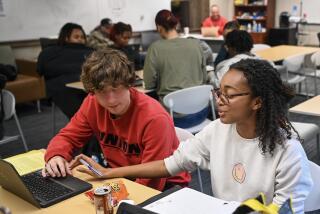If This Were a Term Paper, You Might Have Seen It on the Web
- Share via
School term papers may be going the way of the typewriters once used to write them.
“It’s so easy to cheat and steal from the Internet that I don’t even assign papers anymore,” said Bobbie Eisenstock, an assistant professor of journalism at Cal State Northridge. “I got tired of night after night checking for cheaters.”
Across the country, teachers and professors are abandoning the traditional academic chore of tidy margins and meticulous footnotes because the Internet offers a searchable online smorgasbord of ready-made papers.
“Students are using the Internet like an 8-billion-page, cut-and-pastable encyclopedia,” said John Barrie, owner of a company that makes software to detect plagiarism.
So as the academic year wraps up in Southern California and elsewhere, students increasingly are having their knowledge tested with oral exams and in-class writing exercises. Or they’re being asked to demonstrate their knowledge in unconventional ways -- say, by assuming the role of a colonial pamphleteer railing against the Stamp Act.
Teachers who still assign long papers -- 10 pages or more with footnotes and bibliographies -- often require students to attach companion essays that describe every step of their research and writing. Even then, teachers scour the Internet for suspicious turns of phrase. And some schools are paying thousands of dollars a year for software such as Barrie’s that scans work for plagiarism.
Those programs reveal that about 30% of papers are plagiarized, either totally or in part.
“It’s a massive, massive problem,” said Barrie, whose Turn It In service evaluates 60,000 submissions a day.
To be sure, the urge to cheat is as old as school. Students have long recycled their friends’ and siblings’ papers with their own names on top. But the rise of the Internet has made it easier than ever: Just type in a search term and up come hundreds of cheating choices that can be assembled into a paper with a couple of mouse clicks.
A 2003 study by Rutgers University found that more than a third of college undergraduates had cut and pasted passages from the Internet without attribution. High school teachers and even elementary school instructors said that kids were starting younger, as easy access to the Internet becomes almost as ubiquitous as television.
Rather than spend all of their grading time trying to catch cheaters, teachers are changing their lesson plans.
“The number of term papers assigned over the years has decreased significantly,” said Herman Clay, director of history and social sciences at Los Angeles Unified School District.
Instead, Los Angeles teachers are assigning more in-class written exams, oral reports with visual aids and PowerPoint presentations, said Clay, a former principal of Van Nuys High School.
It’s unclear how many teachers nationwide are doing the same, but it’s enough that some educators worry that kids are missing an important educational experience -- one that requires them to seek out facts and then assemble them into a cogent, sustainable argument.
In-class writing assignments are, by necessity, much shorter exercises that can be as brief as a couple of paragraphs and rarely more than a few pages.
“Kids these days have difficulty writing in depth about anything,” said Nancy Willard, executive director of the Center for Safe and Responsible Internet use. “They are used to doing PowerPoint presentations, and the level of superficiality is great compared with term papers.”
Whether that matters remains to be seen.
“We’re just at the first stage in college with young people who have spent significant amounts of time on the Internet and online,” she said. “We have no idea where we’re going and what’s going to happen with kids and their brains and their ability to do schoolwork.”
Ironically, the shift away from take-home writing assignments comes as standardized tests such as the SAT add essay components.
Although term papers are still required at Warren High School in Downey, a sprawling campus with 3,500 students, there is a shift toward more in-class writing and presentation-oriented projects, said Shirley Stewart, the school’s advanced placement coordinator and English department chairwoman.
Under state testing guidelines, students must learn the minutiae of bibliography protocol, such as what punctuation comes after the name of the publishing company when citing a novel. But they don’t necessarily have to learn it as part of a term paper.
“We’re teaching formatting, and in this Internet age, that seems kind of silly,” said Stewart, who noted that in-class projects combine research and organization and require a mastery of the subject at hand to present in front of teachers.
At Clovis High School outside Fresno, library media teacher Janet Groth requires students to take notes during their research and write rough drafts of papers by hand in class -- then attach them to the final versions.
“It took forever to grade them,” she said, “but they knew I’d be checking and that they’d have to explain any wording.”
The school also fights fire with fire, paying more than $2,000 a year to use Barrie’s Web-based Turn It In, which checks a student’s paper against a database of 17 million essays and papers. Barrie’s Oakland-based company, IParadigms, calculates that the odds of stringing the same 16 words together in the same order as somebody else is less than one in a trillion.
Barrie said he expected the number of Turn It In submissions to climb 66% to 100,000 a day when school resumes this fall.
Los Angeles Unified is experimenting with Turn It In, but the service is not in widespread use.
Students say it’s easy to fall into the trap of copying too much from a website. They say they are squeezed by academics, sports, music and other extracurricular activities to make them appear more attractive to prospective colleges.
And once they’re in college, students say the pressure only increases -- along with the total number of assignments they’re asked to turn in.
“Frequently many students plagiarize an Internet site for an essay they must write because they know the teacher will merely skim it,” said Rachel Koechel, a sophomore at Washington State University, who acknowledged having shared answers for online assignments and said she had seen fellow students submit copied material. “Sometimes students don’t want to spend four hours on an essay that they know isn’t worth a huge amount of their grade, and/or they know it’s not going to be fully read over.”
Websites with names such as Cheathouse.com, Schoolsucks.com and LazyStudents.com cater to that sort of sentiment with come-ons such as “Download your workload” and “If your professor can have a research assistant, why can’t you?”
Charges generally are $10 per page but can be much more for customized assignments.
“If you’re as overwhelmed with homework this semester as I am, you definitely need help with at least a few essays,” reads the opening page of Essayboy, which touts an inventory of more than 25,000 works. “Help is here!”
Schoolsucks.com offers essays for free to allow students to get a feel for topics and the nuances of writing, Yasha Harari, co-owner of the site, said.
“We recommend they read whatever they’re writing about, get a feel for the language, see what others are writing about,” Harari said. “It’s a peer-to-peer study group.”
Harari warned potential cheaters that they get what they pay for.
“We’re the world’s largest collection of free and awful homework,” Harari said. “You’d be a fool to copy our papers and submit it as your own because it’s fully searchable.”
The idea crosses everyone’s mind, said Eric Katz, a junior at the highly competitive Monta Vista High School in the Bay Area’s Cupertino.
“But our school has really stressed that when you get into college, if you plagiarize, you will get caught,” said Katz, who hopes to attend the University of Pennsylvania.
Despite the growing awareness that the same tools that enable plagiarism also make it easier to spot, students persist. Ted Nellen, an English teacher on New York’s Long Island, this year had a student submit a beautiful sonnet -- one that had been written by John Keats.
More to Read
Sign up for Essential California
The most important California stories and recommendations in your inbox every morning.
You may occasionally receive promotional content from the Los Angeles Times.










